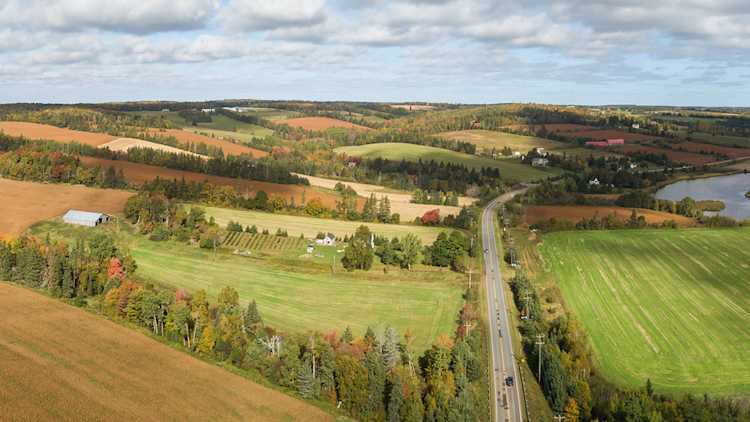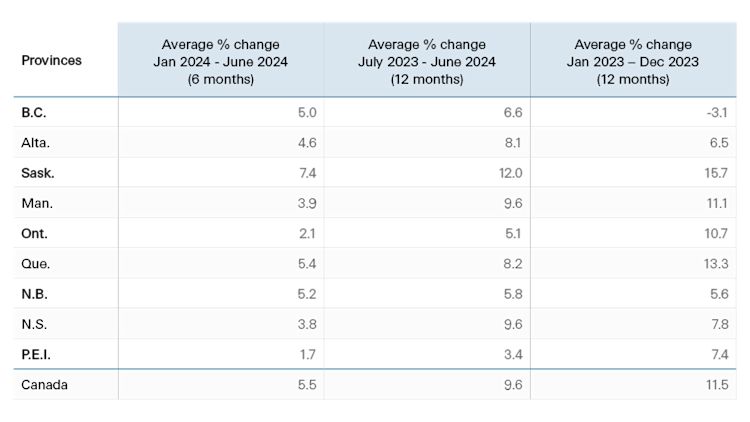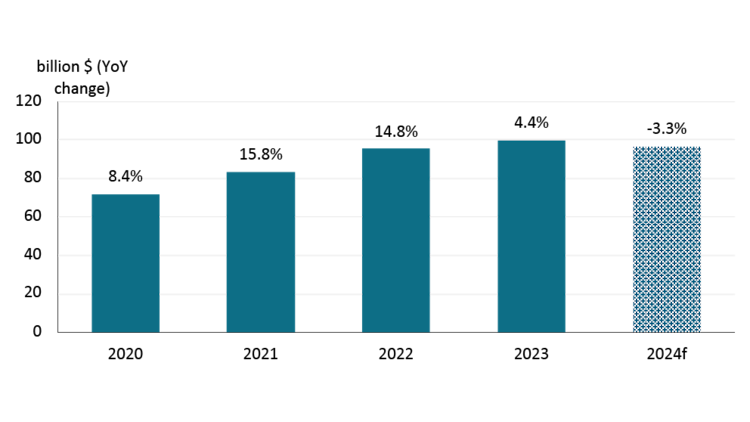2024 mid-year farmland values increase despite lower revenues and elevated interest rates

Canadian cultivated farmland values rose by an average of 5.5% in the first half of 2024 (Table 1). Over the year from July 2023 to June 2024, there was a 9.6% increase, representing a slowdown compared to the previous year, likely the result of lower commodity prices and elevated borrowing costs.
For the second consecutive year, Saskatchewan and Quebec have recorded the highest average 6-month increases in the country, at 7.4% and 5.4%, respectively (Table 1). The rates in New Brunswick, British Columbia, and Alberta all settled in the same range, 5.2%, 5.0%, and 4.6%, respectively. Manitoba recorded a growth rate of 3.9%, closely followed by Nova Scotia at 3.8%. Ontario recorded a lower increase at 2.1%, with Prince Edward Island concluding the list at 1.7%.
Table 1: Average farmland values changes in the first half of 2024 by province

Source: FCC calculations
The dance between interest rates, farm profitability and farmland values
Interest rates are always a major driver of major investment decisions. The economic environment of the previous two years has been characterized by high interest rates due to persistent inflation. The Bank of Canada recently proceeded with reductions in its policy interest rate, with the initial adjustment occurring a little less than a month before our analysis period ended (January 1st to June 30th, 2024). While actual interest rate decisions of the Bank did not likely matter much, expectations of lower interest rates might have played a role. By late January 2024, financial markets were fully pricing in the first rate cut of the Bank of Canada to occur in June. And the expectation at the time would be that the Bank of Canada policy rate would be lowered by 1% by the end of the year. These expectations pushed down interest rates in financial markets and lowered borrowing costs slightly.
Lower interest rates, or expectations of lower borrowing costs, enhances buyers’ willingness to pay, thereby driving up demand. Yet farm revenues matter too. High input costs squeeze profit margins, possibly limiting farmers' capacity to invest in new land and moderating farmland value growth. In the short term, 2023’s strong farm cash receipts (Figure 1) likely contributed to the growth we are reporting now. The limited availability of farmland for sale is also a crucial driver of farmland values.
Figure 1: Farm Cash Receipts

Sources: Statistics Canada, FCC Calculations
Provincial trends
In British Columbia, farmland values have risen by 5.0%, with the Peace-Northern region exhibiting the most significant growth in the province. Additionally, the Okanagan and South Coast regions are also experiencing value increases. The provincial average is largely impacted by the Peace-Northern Region, which contains the majority of the province's arable land. The most recent 12-month average growth rate recorded a rebound (6.6%) after the previous 12-month period registered a decline (-3.1%).
In Alberta, the trend has been toward selling smaller parcels of land, as large holdings are divided into smaller groups to attract more buyers. Additionally, land transactions are increasingly occurring through private sales, live auctions, and sealed tenders. We have observed a 4.6% rise in land values during the first half of 2024, with the most significant increases noted in the northern parts of the province.
Saskatchewan's farmland values keep rising, leading the nation in appreciation. From January to June 2024, the average increase is 7.4%. Northern and central areas are nearing double-digit growth, while southern regions show smaller but positive gains.
Manitoba's 3.9% growth is primarily fueled by the Westman region, with additional support from the Parkland region. The other regions fall below the provincial average. Although Manitoba ranked high in the 2023 Farmland Values report and year-over-year growth, it has dropped to sixth place nationally in this mid-year report.
In Ontario, high-quality farmland remains in demand and sells well, while average to lower quality land either struggles to attract buyers or fetches lower prices. The Central West region has seen the highest increase in land values, unlike the Mid Western region, which shows no growth. Overall, farmland values in Ontario are stable with minor changes across most areas, leading to a provincial average growth of 2.1% at mid-year.
This economic pressure of higher interest rates and lower commodity prices has resulted in a much less pronounced increase in Quebec’s land values compared to recent years. Nonetheless, Quebec is reporting the second highest rate of growth in the country after 6 months. The reported rate of 5.4% is near the national average of 5.5%. The province's rise is primarily due to growth in the central regions of the province (Mauricie-Portneuf, Centre-du-Québec and Chaudière-Appalaches). This strong expansion, however, is counterbalanced by only a modest growth in the regions with the highest per acre farmland values (Montérégie and Laurentides-Lanaudière).
Similar to Quebec, New Brunswick's growth rate is near the national average at 5.2%. The market for potato-producing land there is limited, with larger operations purchasing land at record prices. Nova Scotia continues to attract a few out-of-province buyers, but interprovincial migration has slowed. From January to June, Nova Scotia's growth was 3.8%. Prince Edward Island has seen minimal changes with growth reported at 1.7%.
Summary
Comparing the 2024 figures with the most recent 12-month period and the 2023 Farmland Values Report clearly reveals a small national deceleration in the growth of farmland values. The recent interest rate cuts and anticipated further reductions in the policy rate for the remainder of 2024 (two cuts of 0.25%) and into 2025 (five cuts for a total of 1.25%) should provide support to buyers’ valuations of farmland. Yet farm revenues should remain severely constrained as commodity prices show no signs of rebounding. Check back with us when we release our annual 2024 report in March 2025 for a detailed regional analysis of farmland values.
Article by: Corbin Chau, Data Analyst, Valuations
